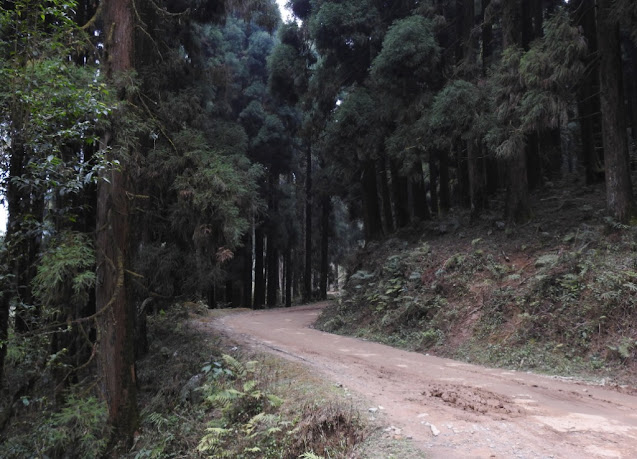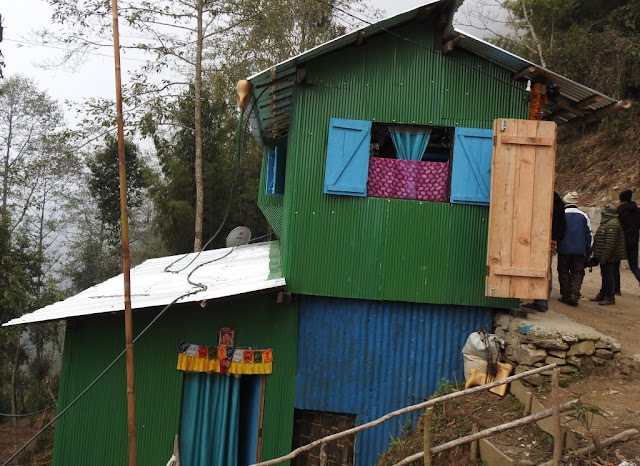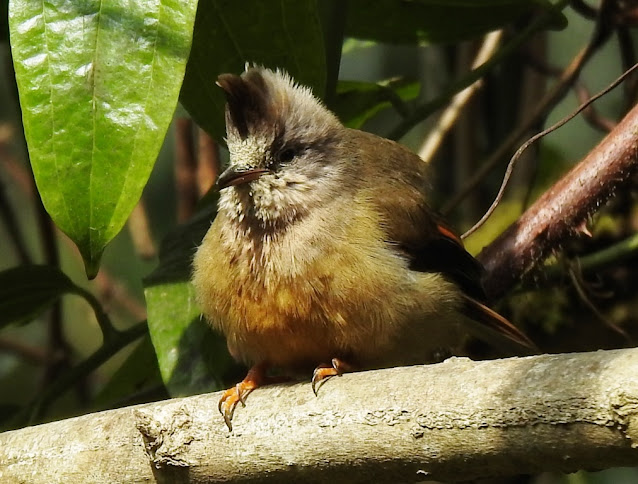The
forests of North Bengal are said to harbor an amazing variety of bird life and,
alluring names like Lava, Neora and Latpanchar only add to their attractiveness.
Why they don’t figure in the primary itinerary of an average birder like myself,
is because of the reputation of this area of being constantly covered in cloud/mist. It was therefore fortuitous that NatureIndia finally
announced their first ever trip to this hidden jewel in the Bengal Himalayas.
Upon
landing at the Bagdogra airport, it was a relief to see a prepaid taxi counter near
the exit since I had planned to to spend a night at Siliguri before joining the
group.
Siliguri
is a typical crowded mofussil town in Bengal with nothing much to offer. Even a
visit to the local “Hongkong market” was not a mitigating factor. The Santra shondesh contained in the actual
rind served at a local restaurant was however quite interesting.
 |
Orange clad shondesh
|
Two
highways emerge from Siliguri going northwards. One to the east going via Sevok
towards Kalimpong / Gangtok and the other slightly to the west going via the
Sukna forest towards Kurseong /Darjeeling. Our plan was to take the Sevok route,
and covering Lava, Neora and Latpanchar in the first leg. Then we were to come
down and take the Sukna axis going upto Rongtong. The entire low level forest
is part of the Mahananda WLS.
 |
Asian pied starling at Teesta river bridge
|
After
a quick lunch stop at the Teesta river bridge, we headed to the Sevoke railway
station described as the the best birding railway station in India!
Just as we stepped onto the platform a
collared falconet put up a spectacular show. Several larger birds could be
seen running helter skelter as this rather tiny raptor approached its high
perch. If only they knew that it’s primarily a butterfly eater!
 |
Collared falconet
|
There
was a relatively unexpected sighting of the oriental pied hornbill apart from some
other good sightings in the area behind the railway track. We were told to be careful
of wild elephants and hurried back as we could hear them in the distance.
Incidentally this part of the railway track is also notorious for elephant
kills.
We
headed towards Lava, not through the conventional Algarh road but from the
southern side. The road was in a reasonably good condition and we reached the
town after dark. The night was cold as is to be expected at 6600 feet. The
morning was overcast but the intermittent sunshine revealed a beautiful small
hill village nestled within a thick pine/ evergreen forest.
 |
Lava village and monastery
|
 |
En route Chaudapheri
|
The
route to Chaudapheri forest camp emerges as a steep upward incline just outside
Lava, but we were able to negotiate the same in our Boleros without the need
for changing into 4X4 vehicles as earlier feared. Probably one of the reasons
why there was a preponderance of Mahindra SUV’s in this part of the country.
 |
Chaudapheri forest camp
|
The
forest camp is nestled beautifully on a hill side and boasts of a tiger photo
on its board. Before anyone could verbalize their doubts, one of the forest
guards proudly held out the picture of a tiger clicked by the camera traps
nearby. While we decided to have
breakfast, the laughingthrushes were already having a feast nearby while
providing mouthwatering photo ops to all of us in bright sunshine that occured
briefly.
 |
Chestnut crowned laughingthrush
|
 |
Black faced laughingthrush
|
 |
Dark breasted finch female
|
The
famous Lava weather took over soon and it became cloudy and cold. Fortunately
it did not rain and we could easily negotiate the slightly slushy tracks. There
were no leeches though.
 |
Dark breasted finch male
|
 |
| Orchid |
 |
Camera trap for tiger census
|
 |
Himalayan bluetail female
|
 |
Bar throated siva foraging on road
|
The
Himalayan bluetails were seen foraging on the roads in large numbers which is
their usual habit. The foraging by bar throated sivas however is considered unusual.
There were good sightings of white and rufous gorgeted flycatchers.
 |
Bull finch
|
The bull
finches made an appearance and represented a species wherein the name just doesn’t
do any justice to the appearance of this strikingly colourful bird. On the
other hand the golden throated barbet seems to be aptly named and gave good
views to everyones satisfaction.
 |
Golden throated barbet
|
We
camped at a place called Kholakham for two nights which seemed uncecessary, since the birding trails were all accessed through
Lava village. Nevertheless the Pinewood resort was picturesque and rather
comfortable, though the power supply seemed to be playing truant. We even
managed to have a hot water bath, which many would consider a luxury on birding
expeditions. The real boon (bane for some of us who want to completely
disconnect from the www) was that there was 4G all along!!
 |
Fire tailed sunbird male moulting
|
Next
day the dazzling early morning show by the firetailed sunbird near the resort brought
cheer even as we were left wondering whether the white spots on its face were
as a result of moulting or the pollen which got stuck. Also sporting the firey
tail was the female, notable as the only female sunbird to adorn any colour
other than green!!
We
were now on the well known, but rather elusive pipeline trail. The entire
northeast birding experience in full glory was on show as we came across
healthy flocks and large numbers of yuhins, rufous sibias, nuthatches,
laughingthrushes and barbets.
 |
Stripe throated yuhina
|
 |
White tailed nuthatch
|
 |
Rufous sibia
|
As
we proceeded up along the Rishyap trail, the clouds moved in but did not
prevent us from getting very good sightings of the large niltava and female
rufous breasted thrush. The highlight was the sudden and dramatic appearance of the cutia, a
lifer for many.
 |
Cutia
|
There were sightings of the rufous breasted wren babbler, the
golden babbler, minivets, black faced warbler and a large flock of black
throated parrotbill which darted around aptly earning the epithet of bullet
birds.
Rishyap
village is another tiny hamlet, notable as a sunrise/Kanchenjunga view point,
where we decided to have a much needed tea break.
 |
Physics class in progress
|
 |
Tea house at Rishyap
|
 |
Rainwater harvesting
|
 |
Russet sparrow
|
It
was incredulous to see the tea house which was actually a duplex, with its own
ingenuous rain water harvesting mechanism fashioned from a cut open oil can.
The lady of the house who was making tea for us was also actually doubling up
as a physics tutor for 9th standard kids of the village!!
 |
Scarlet finch
|
 |
Striated bulbul
|
 |
Scarlet finch male
|
 |
Scarlet finch female
|
 |
Grey cheeked warbler
|
 |
Red tailed minla
|
The
next morning we found ourselves walking on the Russet trail which had been
fenced off for motorized vehicles. It was a bright and sunny day , made
infinitely more glorious by the sighting of scarlet finches perched on the open
forest canopy. The sudden loud calls and subsequent sighting of the bay
woodpecker brought much excitement. Another example of a rather lame
nomenclature for this rather large and colourful woodpecker with a long yellow
bill. Some more prized sightings followed which included a slender billed
scimitar babbler and a flock of coral billed scimitar babblers.
Before
soon we hit the jackpot in the form a large mixed hunting party of bigger sized
birds. Something different from the usual MHPs of the north east consisting of
the smaller birds. This congregation was along a dried waterfall which drew
attention by the presence of the scarlet finches but resulted in the
spectacular sighting of the red faced liocichla and the blue winged
laughingthrush.
 |
Red faced liocichla
|
The
uncannily large appearing black eagle with upturned wingtips was seen
intermittently hovering just above the forest conopy. The crested goshawk identifiable
by its white side markings also made its appearance. Just as we were proceeding
through the Lava village near the construction site of the water tank, the
thrilling sight of a Himalayan buzzard trying to take off with a chicken played
out. The prey however turned out to be too heavy for the raptors talons and he
had to let it go!! The pale morph of the bird was also seen later.
 |
Himalayan buzzard
|
 |
GNLF office at Kalimpong
|
 |
Gorkhaland!?
|
 |
Kalimpong main street
|
The
plan was to now leave the Neora valley and travel past Kalimpong which is a bustling , touristy hill town with few
reminders of its not so remote violent past.
Latpanchar
is a nondescript hilly hamlet approached by a steep road rising from Kalijhora
on the Siliguri Gangtok road. As early
as 1943, the Britishers found the terrain to be suitable for cultivation of
Cinchona from which the drug quinine is extracted. Also grown as a cash crop is the broom-grass, Thysanolaena
maximum, which grows most abundantly in the North-east. What was not considered
of commercial value, however, was the wild figs which grew abundantly on the
trees in the village the surrounding valley.
 |
Broom grass
|
These
happen to be the favourite food for the rufous necked hornbills, several pairs
of which therefore existed here since antiquity. In fact the birds would nest on the trees in
some of the village houses.
In
2011 a birder happened to take and post some excellent pictures of this spectacular
and otherwise elusive bird in all its glory since they were spottable from the
road itself and not shy of the people down below. The destiny of the village transformed
overnight. Now the place is synonymous with hornbill tourism and several homestays
have mushroomed to accommodate the hordes of birders and photographers for whom
a visit here is nothing short of a pilgrimage.
 |
Rufous necked hornbill male
|
 |
Rufous necked hornbill female
|
The
life cycle of rofous necked hornbill is quite interesting in itself
notwithstanding its gobsmaking appearance. Once the pair decides to mate and
lay eggs, the female enters into a tree hole (made by other birds, since its extraordinary
and strange beak is incapable of doing so). Once inside she sheds her feathers
to line the nest for the eggs and the hole is sealed by the male leaving only a
narrow slit. Through this slit he provides food for the female as well as the
hatchlings. It’s only after three months that the female emerges. By this time
the hatchlings are airworthy and she has also regenerated her wings. Any
premature exit by her would be impossible since she is flightless during that
time!!
 |
Hornbill nest
|
We
were duly obliged with good sightings of the famed hornbills leaving us in a
state little short of apoplexy!!
Also
spectacular were the brief sightings of the common green magpie, the sapphire
flycatcher and the long tailed broadbill. A resident Asian barred owlet seemed to take
no notice of a large number of chirping schoolkids. The quest for formal
education in Latpanchar and the surrounding hamlets stands out, as children, especially girls, were found happily trekking several kilometers to
attend school. More heartening was to see their parents letting and helping them
do so!
 |
School children
|
 |
Latpanchar primary school Estd 1946
|
 |
Great barbet
|
 |
Asian barred owlet
|
 |
Blue throated barbet
|
 |
Cinchona plantation : The british legacy
|
 |
Free spirited youth
|
 |
Paris peacock butterfly
|
 |
Orange planations
|
We
descended towards Siliguri and spent the night at a hotel in Silbari, which is located
on the old Darjeeling road. This has been made famous in the movie Aradhana for
its railtrack- adjoining- road sequence, featuring the heritage narrow gauge Darjeeling
express. Luckily there is a new road for Darjeeling now and so the road traffic
is rather sparse.
 |
Hill cart road in Sukhna forest
|
 |
Rongtong station
|
The
next mornings birding was along this very road/rail track and was nothing short
of fabulous. The forest was alive with bird activity under a glorious sunshine
as crimson sunbirds, ioras, bulbuls and orioles and minivets were flitting
about in huge numbers. The white bellied yuhina (Erpornis) and white tailed
shama also made an appearance.
We
were rewarded with good sightings of a pair of crested tree swifts, which is
one of the few types of swift which actually sit on tree tops and allow
themselves to be easily photographed.
We
went upto the Rongtong station and helped ourselves to a hearty breakfast
with a lot of birding happening around this pitstop.
 |
Crimson sunbird
|
 |
Erpornis
|
 |
Red whiskered bulbul
|
 |
Common Iora
|
 |
Crested tree swift male
|
 |
Spotted dove
|
 |
Black hooded oriole
|
The
final show of the trip was put up by a young Shikra which had hunted a calotis
and made short work of it ,completely unfazed by the machine gun like sounds of
furiously clicking camera shutters.
(Alas there is no silent mode on these large cameras as we were told!!)
 |
Shikra eating calotis
|
The
plan was to continue birding along this very productive road till evening, but
we had to return for lunch to our hotel due to some change of plans by our
local guide.
After
some rest we headed back to the New Jalpaiguri railway station. A shoe emergency
of one of the participants left us wondering how we were going to find a
cobbler. But the coolies at the station assured us that the men sitting with
boot polish stands are also equipped to handle repairs. We believed this amazing
resourcefulness only when the shoe polish man was summoned on site and he whipped
out his suturing equipment with a flourish from the little drawer in the polish
stand. He not only stitched the affected shoe and provided a new insole but
also did some prophylactic work on the other shoe! Someone also noticed that he
worked on the unaffected shoe first!!
Indeed
some of the most valuable business, and indeed life’s, lessons are unexpectedly
learnt when one travels..
 |
Service and the smile
|
 |
Clean station
|
The
NJP station also brought about further amazement when we walked into a squeaky
clean station. Not only were there escalators for going up to the over bridge
and elevators for coming down with the luggage, all of them were in top working
condition. I’m sure many of us thought
of a certain bearded chaiwala whose efforts were finally showing results. Swach
Bharat is of course a mindset, which will probably need a few generations to take
root, but the nuts and bolts of it seem to be in place...
Trip
details:
Travel
dates – 02 to 07 March 2019
Tour
operators – NatureIndia
Group
size – 10
Camera
– Nikon P900
Transportation
– Mahindra Bolero
Stay:
Yankee
resort, Lava
Pinewood
resort, Kholakham
Kharkha
homestay, Latpanchar
Oyo,
Greenwood, Silbari on Hill Cart road (Beware of the wrong google map location apparently
created by a competitor!)
Tips:
If
one wants normal tea, it has to be specified as milk tea.
Premix
tea and coffee are a good idea to carry since hot water is made available early
in the morning.
Only
BSNL signal is available at Latpanchar.
 |
| Pinewood , Kholakham |
 |
| Kharkha homestay , Latpanchar |
 |
| Yankee resort , Lava | | | |















































































